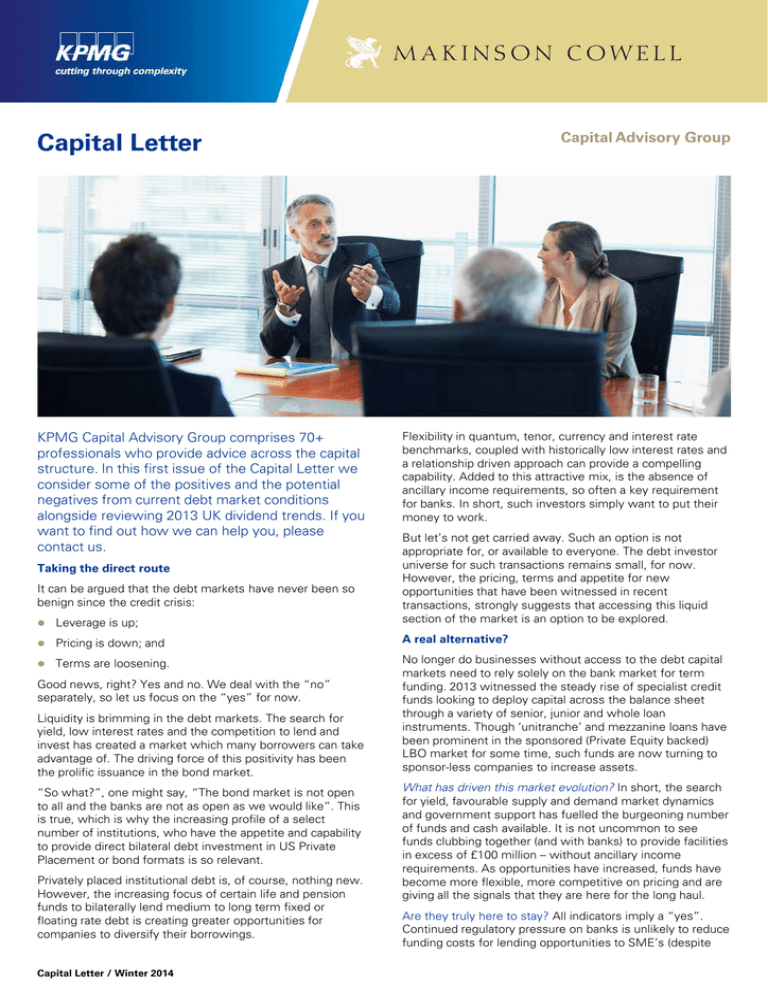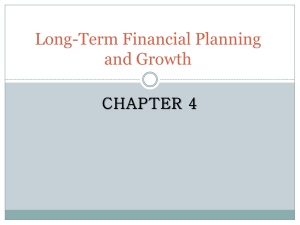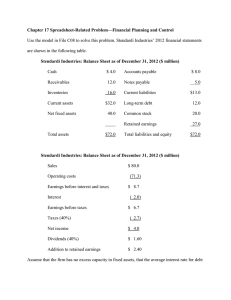
Capital Advisory Group
Capital Letter
KPMG Capital Advisory Group comprises 70+
professionals who provide advice across the capital
structure. In this first issue of the Capital Letter we
consider some of the positives and the potential
negatives from current debt market conditions
alongside reviewing 2013 UK dividend trends. If you
want to find out how we can help you, please
contact us.
Flexibility in quantum, tenor, currency and interest rate
benchmarks, coupled with historically low interest rates and
a relationship driven approach can provide a compelling
capability. Added to this attractive mix, is the absence of
ancillary income requirements, so often a key requirement
for banks. In short, such investors simply want to put their
money to work.
Leverage is up;
But let’s not get carried away. Such an option is not
appropriate for, or available to everyone. The debt investor
universe for such transactions remains small, for now.
However, the pricing, terms and appetite for new
opportunities that have been witnessed in recent
transactions, strongly suggests that accessing this liquid
section of the market is an option to be explored.
Pricing is down; and
A real alternative?
Terms are loosening.
No longer do businesses without access to the debt capital
markets need to rely solely on the bank market for term
funding. 2013 witnessed the steady rise of specialist credit
funds looking to deploy capital across the balance sheet
through a variety of senior, junior and whole loan
instruments. Though ‘unitranche’ and mezzanine loans have
been prominent in the sponsored (Private Equity backed)
LBO market for some time, such funds are now turning to
sponsor-less companies to increase assets.
Taking the direct route
It can be argued that the debt markets have never been so
benign since the credit crisis:
Good news, right? Yes and no. We deal with the “no”
separately, so let us focus on the “yes” for now.
Liquidity is brimming in the debt markets. The search for
yield, low interest rates and the competition to lend and
invest has created a market which many borrowers can take
advantage of. The driving force of this positivity has been
the prolific issuance in the bond market.
“So what?”, one might say, “The bond market is not open
to all and the banks are not as open as we would like”. This
is true, which is why the increasing profile of a select
number of institutions, who have the appetite and capability
to provide direct bilateral debt investment in US Private
Placement or bond formats is so relevant.
Privately placed institutional debt is, of course, nothing new.
However, the increasing focus of certain life and pension
funds to bilaterally lend medium to long term fixed or
floating rate debt is creating greater opportunities for
companies to diversify their borrowings.
Capital Letter / Winter 2014
What has driven this market evolution? In short, the search
for yield, favourable supply and demand market dynamics
and government support has fuelled the burgeoning number
of funds and cash available. It is not uncommon to see
funds clubbing together (and with banks) to provide facilities
in excess of £100 million – without ancillary income
requirements. As opportunities have increased, funds have
become more flexible, more competitive on pricing and are
giving all the signals that they are here for the long haul.
Are they truly here to stay? All indicators imply a “yes”.
Continued regulatory pressure on banks is unlikely to reduce
funding costs for lending opportunities to SME’s (despite
the recent amendment to the flagship Funding for Lending
Scheme) and investors continue to seek yield. Funds appear
to be balancing returns with meeting borrowers’ needs and
look on course to continue to raise capital.
So how accessible are these funds? Although access
remains more likely for sponsored borrowers where yields
are likely to be higher and sponsors seeking double digit
equity returns provide comfort, funds are casting the net
further afield. The desire to deploy capital and a traditional
credit driven approach provides an attractive mix for an
appropriate borrower.
London market set for 6% dividend growth in 2013
Estimates of earnings growth for the FTSE All-Share have
steadily declined through 2013 yet dividend growth has
remained resilient. On the basis of consensus sell-side
estimates for constituent companies taken from Thomson
Reuters, aggregate 2013 earnings look set to be marginally
lower than that for the prior year, which in turn was 4% lower
than 2011. Dividends for the market for 2012 increased by 8%
and the data is still showing a growth rate of almost 6% for
2013.
2013 estimated FTSE All-Share growth contribution
Earnings growth
Dividend growth
8.0%
6.0%
4.0%
2.0%
0.0%
(2.0%)
(4.0%)
(6.0%)
Oil & Gas, Mining and Pharma
Rest of Market
Total growth
Source: Thomson Reuters, KPMG analysis
The earnings headwind
Will we never learn?
When it comes to financial markets, we may forever be in a
cycle of boom or bust. The amplitude and frequency of the
cycles may vary but we seem incapable of learning from our
mistakes. The world is recovering from severe financial
crisis created by over-exuberant lending but it is doing so
now on a diet of ridiculously cheap money and in the
process creating flawed foundations that guarantee future
problems. Across many of the world's major economies,
returns on cash are negative in real terms, so cash chases
yield. Yield comes in many forms but it also comes with
risk.
Consider the following: leverage finance multiples in the US
are nearly back to where they were pre crisis, yet around
50% of all this year's transactions have been "money out".
In other words, debt investors putting in money to allow
shareholders to take money off the table. "Covenant-lite"
loans which offer fewer protections for lenders are back in
the market and they already account for 55% of new
leveraged loans1. Cov-lite loans are making up record levels
in debt packages sold to investors. Sliced and diced
collateralised loan obligations are back, some which permit
up to 70% of their assets being in cov-lite loans. Elsewhere
there are structures with PIK toggle notes, for the layman
instruments where the borrower only pays interest when it
can if it wants.
So we think the answer to our question is an emphatic "no,
we will never learn"........but let us know if you disagree.
Earnings for Oil & Gas Producers and Mining stocks have
deteriorated significantly over the past two years, as production
declines, operational setbacks and the swing in the
commodities cycle have all exerted significant pressure on
profits at some of the UK’s largest companies. In addition, we
note that the Pharmaceuticals sector continues to face a stern
test of its own as firms continue to navigate their way through
patent expiries of blockbuster drugs whilst also dealing with an
increasingly hostile regulatory environment. These three
sectors are amongst the lowest rated by P/E in the UK market
and, as a group, account for approximately 40% of profits1 and
30% of the market’s capitalisation2. In aggregate, they are
expected to post a 2013 earnings decline of approximately
11%3 but, given the strength of balance sheets and access to
cheap borrowings, they are currently forecast to grow
dividends by around 3%3. This is important for the health of the
equity market overall at a time when investors are chasing
yield.
Progress across other sectors
Elsewhere in the London market, Financials are expected to
post earnings and dividend growth of 7% and 9%3
respectively, while for the remainder of the market excluding
Financials, Resources and Pharmaceuticals, earnings are
expected to grow at 5%3 and dividends by 6.5%3 compared
with 2012. The expectation that dividends will continue to grow
reflects the strength of company balance sheets, relatively high
levels of dividend cover and, to some degree, a lack of suitable
investment opportunities. With this in mind, our insight into
investor perceptions underscores the support for sustainable
progressive dividends as part of a balanced capital allocation
framework.
Source: 1KPMG analysis
2
Bloomberg, KPMG analysis
3 Thomson
Reuters, KPMG analysis
Source: 1Financial Times
Contact us
Neill Thomas
Corporate Finance
T: +44 (0) 20 7311 4757
E: neill.thomas@kpmg.co.uk
www.kpmg.co.uk
Bob Cowell
Corporate Finance
T: +44 (0) 20 7670 2500
E: rdc@makinson-cowell.co.uk
The information contained herein is of a general nature and is not intended to address the
circumstances of any particular individual or entity. Although we endeavour to provide accurate and
timely information, there can be no guarantee that such information is accurate as of the date it is
received or that it will continue to be accurate in the future. No one should act on such information
without appropriate professional advice after a thorough examination of the particular situation.
© 2014 Makinson Cowell Limited (“MC”). MC is a subsidiary of KPMG LLP, a UK limited liability
partnership and a member firm of the KPMG network of independent member firms affiliated with
KPMG International Cooperative, a Swiss entity. All rights reserved. Makinson Cowell is authorised
and regulated by the Financial Conduct Authority.
Designed and produced by Create Graphics | Publication Number: CRT008325







